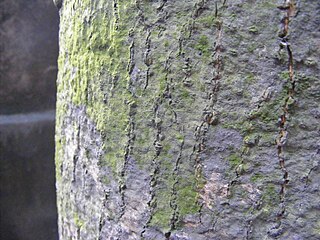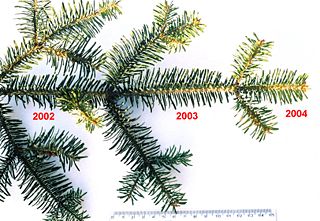
In botany, an evergreen is a plant that has leaves throughout the year that are always green. This is true even if the plant retains its foliage only in warm climates, and contrasts with deciduous plants, which completely lose their foliage during the winter or dry season. There are many different kinds of evergreen plants, both trees and shrubs. Evergreens include:
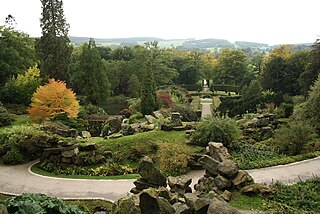
A rock garden, also known as a rockery or an alpine garden, is a small field or plot of ground designed to feature and emphasize a variety of rocks, stones, and boulders.
A mulch is a layer of material applied to the surface of soil. Reasons for applying mulch include conservation of soil moisture, improving fertility and health of the soil, reducing weed growth and enhancing the visual appeal of the area.

A perennial plant or simply perennial is a plant that lives more than two years. Some sources cite perennial plants being plants that live more than three years. The term is often used to differentiate a plant from shorter-lived annuals and biennials. The term is also widely used to distinguish plants with little or no woody growth from trees and shrubs, which are also technically perennials.
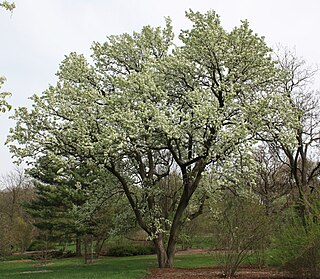
Pyrus calleryana , or the Callery pear, is a species of pear tree native to China and Vietnam, in the family Rosaceae. It is most commonly known for its cultivar 'Bradford', widely planted throughout the United States and increasingly regarded as an invasive species.
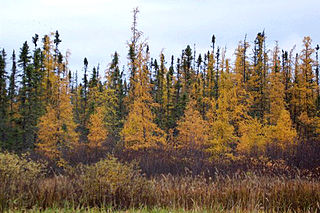
Larix laricina, commonly known as the tamarack, hackmatack, eastern larch, black larch, red larch, or American larch, is a species of larch native to Canada, from eastern Yukon and Inuvik, Northwest Territories east to Newfoundland, and also south into the upper northeastern United States from Minnesota to Cranesville Swamp, West Virginia; there is also an isolated population in central Alaska. The word tamarack is an Algonquian name for the species and means "wood used for snowshoes".

Paulownia tomentosa is a deciduous tree in the family Paulowniaceae, native to central and western China. It is an extremely fast-growing tree, and is a persistent exotic invasive in North America.

Carpinus betulus, commonly known as the European or common hornbeam, is a hornbeam native to Western Asia and central, eastern, and southern Europe, including southern England. It requires a warm climate for good growth, and occurs only at elevations up to 600 metres (1,969 ft). It grows in mixed stands with oak, and in some areas beech, and is also a common tree in scree forests. Hornbeam was also known as 'Yoke Elm'.

Hevea is a genus of flowering plants in the spurge family, Euphorbiaceae, with about ten members. It is also one of many names used commercially for the wood of the most economically important rubber tree, H. brasiliensis. The genus is native to tropical South America but is widely cultivated in other tropical countries and naturalized in several of them. It was first described in 1775.

Betula papyrifera is a short-lived species of birch native to northern North America. Paper birch is named for the tree's thin white bark, which often peels in paperlike layers from the trunk. Paper birch is often one of the first species to colonize a burned area within the northern latitudes, and is an important species for moose browsing. The wood is often used for pulpwood and firewood.

Pistacia chinensis is a small to medium-sized tree in the genus Pistacia in the cashew family, Anacardiaceae, native to central and western China. It is hardy, can withstand harsh conditions and poor quality soils, and grows up to 20 m. The leaves are deciduous, alternate, pinnate, 20–25 cm long, with 10 or 12 leaflets, the terminal leaflet usually absent. The flowers are produced in panicles 15–20 cm long at the ends of the branches; it is dioecious, with separate male and female plants. The fruit is a small red drupe, turning blue when ripe, containing a single seed. This species is planted as a street tree in temperate areas worldwide due to its attractive fruit and autumn foliage.
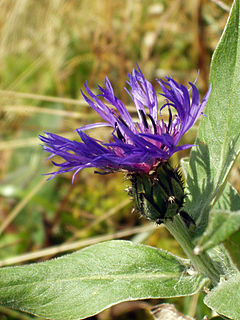
Centaurea montana is a species of Centaurea endemic to Europe. It is widespread and common in the more southerly mountain ranges of Europe, but is rarer in the north. It escapes from gardens readily, and has thereby become established in the British Isles, Scandinavia and North America.
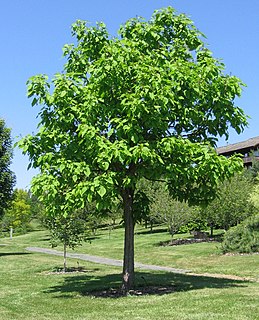
Catalpa speciosa, commonly known as the northern catalpa, hardy catalpa, western catalpa, cigar tree, catawba-tree, or bois chavanon, is a species of Catalpa native to the midwestern United States.

Natural landscaping, also called native gardening, is the use of native plants, including trees, shrubs, groundcover, and grasses which are indigenous to the geographic area of the garden.

Aloidendron barberae, formerly Aloe barberae, also known as the tree aloe, is a species of succulent plant in the genus Aloidendron. It is native to South Africa northwards to Mozambique. In its native climes this slow-growing tree can reach up to 18 m (54 ft) high and 0.9 m (3 ft) in stem diameter. Aloidendron barberae is Africa's largest aloe-like plant. The tree aloe is often used as an ornamental plant. Its tubular flowers are rose pink (green-tipped); it flowers in winter and in its natural environment is pollinated by sunbirds.

Stewartia malacodendron, the silky camellia, silky stewartia or Virginia stewartia, is a species of flowering plant in the family Theaceae. It grows slowly into a large deciduous shrub or small tree, typically 3–4.5 m (10–15 ft) tall, but sometimes as tall as 9 m (30 ft). It is native to the southeastern United States.

Plumeria rubra is a deciduous plant species belonging to the genus Plumeria. Originally native to Mexico, Central America, Colombia and Venezuela, it has been widely cultivated in subtropical and tropical climates worldwide and is a popular garden and park plant, as well as being used in temples and cemeteries. It grows as a spreading tree to 7–8 m (23–26 ft) high and wide, and is flushed with fragrant flowers of shades of pink, white and yellow over the summer and autumn.
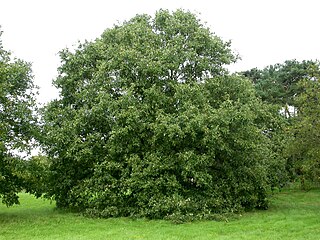
Quercus libani, the Lebanon oak, is a species of oak native to the eastern Mediterranean in western Asia, including in Lebanon, western Syria, northeastern Israel, eastern Turkey, and northern Iraq and Iran.
Pyrus cordata, the Plymouth pear, is a rare wild species of pear belonging to the family Rosaceae. It gets its name from the city of Plymouth in Devon, where it was originally found in 1870 The Plymouth pear was one the British trees to be funded under English Natures Species Recovery Programme.

Introduction





